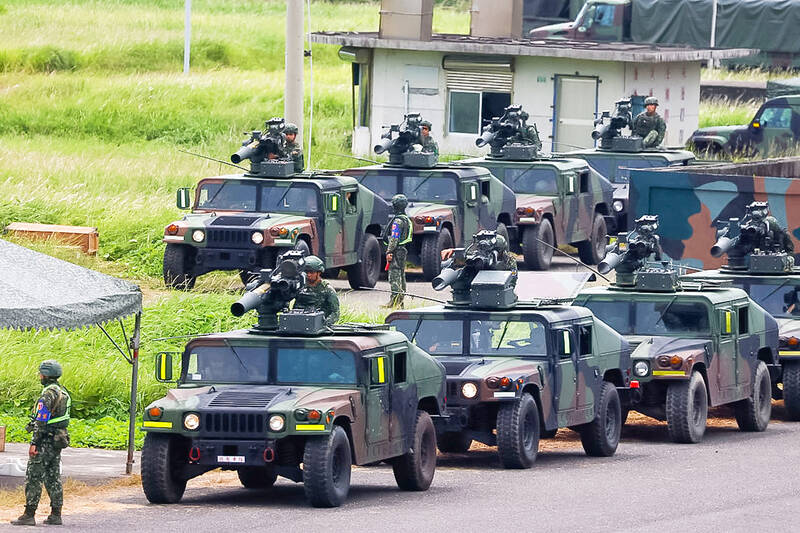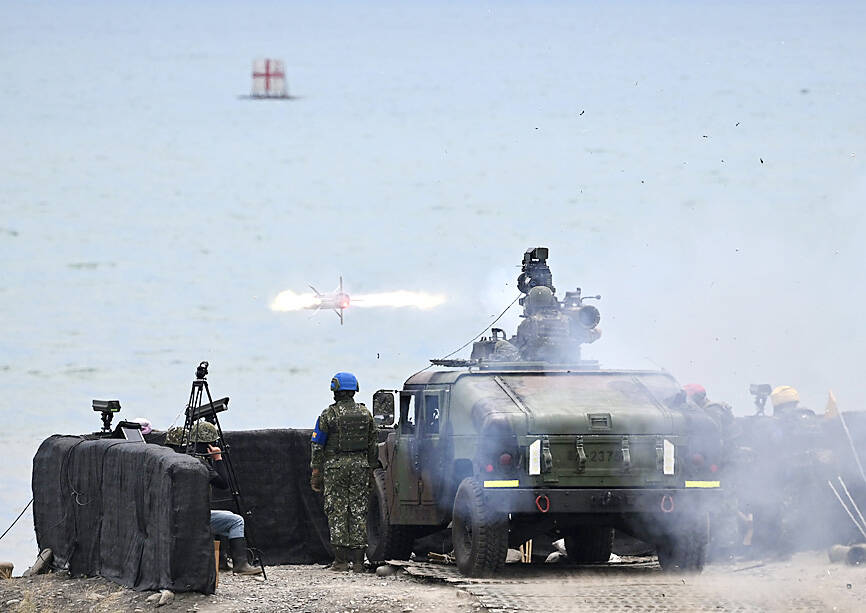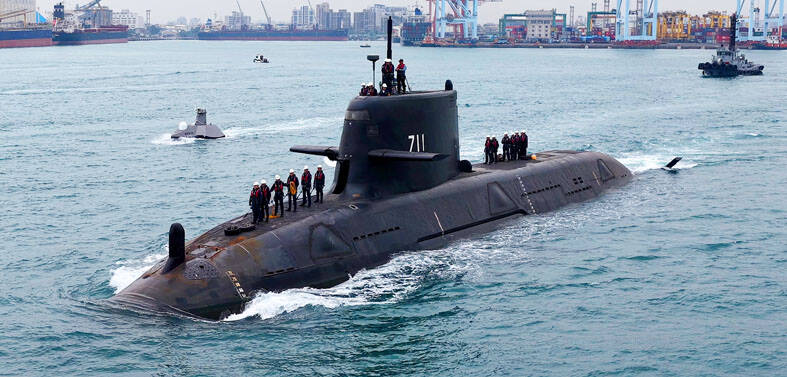The military yesterday held live-fire exercises involving precision weapons in Pingtung County to test troops’ capabilities to counter potential amphibious and sea attacks by China.
The “Sky Horse” exercises were open to the media and involved troops from the army’s 542nd, 564th, 269th and 234th brigades, Hualien Defense Command, Army Infantry Training Command and the 99th Marine Brigade.
During the drills, soldiers fired TOW 2A anti-tank missiles at targets in the sea from a coastal drill area in Fangshan Township (枋山).

Photo: Ann Wang, Reuters
Major Huang Chieh-hung (黃介宏), an instructor from the Army Infantry Training Command who was in charge of the drill, said the soldiers used sighting devices to boost the missiles’ accuracy, adding that about 70 percent of the projectiles hit their designated targets at sea.
The major difference between this year’s Sky Horse exercise and previous ones is that TOW 2B anti-tank missiles were fired from vehicles instead of from the ground, he said.
Firing missiles from a vehicle increases mobility and helps soldiers defend against enemy attacks by engaging effectively at an early stage, Huang added.

Photo: Lo Pei-de, Taipei Times
Taiwan has purchased 1,240 TOW 2B anti-tank missiles, 24 Humvee armored vehicles upon which the missiles would be mounted and 30 targeting systems from the US, the Ministry of National Defense has said.
The weapons are to be delivered by 2025, the ministry said.
The military also held a live-fire exercise involving helicopters and Thunderbolt-2000 rocket systems at a separate drill ground in Pingtung.
Today, the armed forces are to hold live-fire exercises that would involve Avenger air-defense systems and Stinger surface-to-air missiles.
The drills come against the backdrop of aerial and naval maneuvers by China in and around the Taiwan Strait.
Last month, eight Chinese warplanes approached Taiwan’s contiguous zone — or the band of sea within 24 nautical miles (44km) of its coast.
In May, China’s Shandong aircraft carrier group sailed through the Taiwan Strait in a rare voyage.
Additional reporting by AFP

US climber Alex Honnold is to attempt to scale Taipei 101 without a rope and harness in a live Netflix special on Jan. 24, the streaming platform announced on Wednesday. Accounting for the time difference, the two-hour broadcast of Honnold’s climb, called Skyscraper Live, is to air on Jan. 23 in the US, Netflix said in a statement. Honnold, 40, was the first person ever to free solo climb the 900m El Capitan rock formation in Yosemite National Park — a feat that was recorded and later made into the 2018 documentary film Free Solo. Netflix previewed Skyscraper Live in October, after videos

NUMBERS IMBALANCE: More than 4 million Taiwanese have visited China this year, while only about half a million Chinese have visited here Beijing has yet to respond to Taiwan’s requests for negotiation over matters related to the recovery of cross-strait tourism, the Tourism Administration said yesterday. Taiwan’s tourism authority issued the statement after Chinese-language daily the China Times reported yesterday that the government’s policy of banning group tours to China does not stop Taiwanese from visiting the country. As of October, more than 4.2 million had traveled to China this year, exceeding last year. Beijing estimated the number of Taiwanese tourists in China could reach 4.5 million this year. By contrast, only 500,000 Chinese tourists are expected in Taiwan, the report said. The report

Temperatures are forecast to drop steadily as a continental cold air mass moves across Taiwan, with some areas also likely to see heavy rainfall, the Central Weather Administration (CWA) said. From today through early tomorrow, a cold air mass would keep temperatures low across central and northern Taiwan, and the eastern half of Taiwan proper, with isolated brief showers forecast along Keelung’s north coast, Taipei and New Taipei City’s mountainous areas and eastern Taiwan, it said. Lows of 11°C to 15°C are forecast in central and northern Taiwan, Yilan County, and the outlying Kinmen and Lienchiang (Matsu) counties, and 14°C to 17°C

STEERING FAILURE: The first boat of its class is experiencing teething issues as it readies for acceptance by the navy, according to a recent story about rudder failure The Hai Kun (海鯤), the nation’s first locally built submarine, allegedly suffered a total failure of stern hydraulic systems during the second round of sea acceptance trials on June 26, and sailors were forced to manually operate the X-rudder to turn the submarine and return to port, news Web site Mirror Daily reported yesterday. The report said that tugboats following the Hai Kun assisted the submarine in avoiding collisions with other ships due to the X-rudder malfunctioning. At the time of the report, the submarine had completed its trials and was scheduled to begin diving and surfacing tests in shallow areas. The X-rudder,